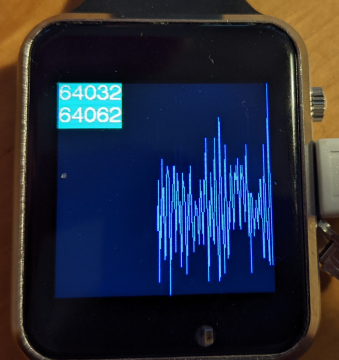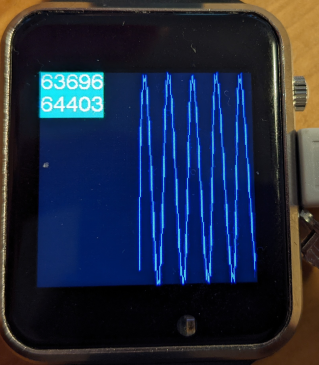Using the built-in microphone on the T-WATCH V3
(EN google-translate)
(PL google-translate)
|
Possible uses of the microphone
|

Bild 0-1: Representation of silence or background noise: The waveform is chaotic and the difference between the minimum (64032) and maximum (64062) is very small.

Bild 0-2: Representation of a whistling tone (almost a sine wave). The difference between the minimum (63696) and maximum (64403) is significantly greater. In principle, the fundamental frequency of the tone could be determined.
Determining the frequency of the whistling sound
|
Initialization of the microphone in the setup function
|
I2S_CHANNEL_MONO, I2S_BITS_PER_SAMPLE_16BIT, ... are predefined constants.
Using the microphone in the loop function
|
 TWATCH_PROC023_Microphone.zip -- Test example (project for the Arduino IDE)
TWATCH_PROC023_Microphone.zip -- Test example (project for the Arduino IDE)
#include "twatch.h"
#include "variables.h"
#include "functions.h"
//for microphone:
#include <driver/i2s.h>
#define BUFFER_SIZE (2*128)
// TWATCH 2020 V3 PDM microphone pin
#define MIC_DATA 2
#define MIC_CLOCK 0
uint8_t buffer[BUFFER_SIZE] = {0};
int x=0;
int micvalue=0;
int micvalue_old=0;
int minimum=0;
int maximum=0;
void setup()
{
setupTWATCH();
//begin setup microphone
i2s_config_t i2s_config = {
.mode = (i2s_mode_t)(I2S_MODE_MASTER | I2S_MODE_RX | I2S_MODE_PDM),
.sample_rate = 44100,
.bits_per_sample = I2S_BITS_PER_SAMPLE_16BIT,
.channel_format = I2S_CHANNEL_FMT_RIGHT_LEFT,
.communication_format = (i2s_comm_format_t)(I2S_COMM_FORMAT_I2S | I2S_COMM_FORMAT_I2S_MSB),
.intr_alloc_flags = ESP_INTR_FLAG_LEVEL1,
.dma_buf_count = 2,
.dma_buf_len = 128,
};
i2s_pin_config_t i2s_cfg;
i2s_cfg.bck_io_num = I2S_PIN_NO_CHANGE;
i2s_cfg.ws_io_num = MIC_CLOCK;
i2s_cfg.data_out_num = I2S_PIN_NO_CHANGE;
i2s_cfg.data_in_num = MIC_DATA;
i2s_driver_install(I2S_NUM_0, &i2s_config, 0, NULL);
i2s_set_pin(I2S_NUM_0, &i2s_cfg);
i2s_set_clk(I2S_NUM_0, 44100, I2S_BITS_PER_SAMPLE_16BIT, I2S_CHANNEL_MONO);
//end setup microphone
setFont(1,255,255,255, 0,255,0);
stroke(0,0,255);
backlight(true);
}
void loop()
{
size_t read_len = 0;
i2s_read(I2S_NUM_0, (char *) buffer, BUFFER_SIZE, &read_len, portMAX_DELAY);
minimum = buffer[0*2]+buffer[0*2+1]*256;
maximum = minimum;
for (int i = 0; i < BUFFER_SIZE/2 ; i++)
{
micvalue = buffer[i*2]+buffer[i*2+1]*256;
if(micvalue>maximum) maximum = micvalue;
if(micvalue<minimum) minimum = micvalue;
}
clear();
for (int i = 0; i < BUFFER_SIZE/2 ; i++)
{
micvalue = buffer[i*2]+buffer[i*2+1]*256;
micvalue-=minimum;
micvalue*=height;
micvalue/=(maximum-minimum);
line(i+110,micvalue_old,i+111,micvalue);
micvalue_old = micvalue;
}
//micvalue = buffer[0*2]+buffer[0*2+1]*256;
cursor(0,0);
editor(minimum);
editor("\n");
editor(maximum);
delay(100);
}
Code 0-1: Example source code -- setup and loop functions in the main tab.
Tab twatch.h
void setupTWATCH()
{
//Serial.begin(115200); //weglassen, sonst ev. im Normalbetrieb Probleme
watch = TTGOClass::getWatch();
watch->begin();
// Turn on the backlight .. aber nicht nur das!!!!
watch->openBL();
tft = watch->tft;
sensor = watch->bma;
hintergrundlicht = watch->bl; //Hintergrundlicht als Objekt verfügbar machen!
// Accel parameter structure (siehe Kommentare in Originalbeispiel!)
Acfg cfg;
cfg.odr = BMA4_OUTPUT_DATA_RATE_100HZ;
cfg.range = BMA4_ACCEL_RANGE_2G;
cfg.bandwidth = BMA4_ACCEL_NORMAL_AVG4;
cfg.perf_mode = BMA4_CONTINUOUS_MODE;
// Configure the BMA423 accelerometer
sensor->accelConfig(cfg);
// Enable BMA423 accelerometer
sensor->enableAccel();
// You can also turn it off
// sensor->disableAccel();
// Some display settings
//tft->setTextColor(random(0xFFFF));
tft->setTextColor(TFT_GREEN, TFT_BLACK);
//tft->drawString("BMA423 accel", 25, 50, 4);
tft->setTextFont(4);
//tft->setTextColor(TFT_WHITE, TFT_BLACK);
//Check if the RTC clock matches, if not, use compile time
watch->rtc->check();
//Synchronize time to system time
watch->rtc->syncToSystem();
// Get the current data
tnow = watch->rtc->getDateTime();
//wav Tongenerator
/*
watch->enableAudio();
watch->enableLDO3();
file_wav = new AudioFileSourceFunction(1.);
file_wav->addAudioGenerators(sine_wave);
#if defined(STANDARD_BACKPLANE)
output_wav = new AudioOutputI2S(0, 1);
#elif defined(EXTERNAL_DAC_BACKPLANE)
output_wav = new AudioOutputI2S();
//External DAC decoding
output_wav->SetPinout(TWATCH_DAC_IIS_BCK, TWATCH_DAC_IIS_WS, TWATCH_DAC_IIS_DOUT);
#endif
wav_generator = new AudioGeneratorWAV();
wav_generator->begin(file_wav, output_wav);
*/
}
Code 0-2: General setup function for the T-WATCH, tab twatch.h in project TWATCH_PROC023. The section for initializing sound generation had to be commented out!